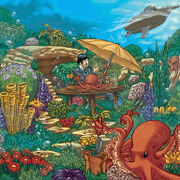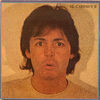No edit summary |
No edit summary |
||
| Line 1: | Line 1: | ||
| − | [[File:Octopus's_Garden.jpg|thumb|An Octopus's Garden]] |
+ | [[File:Octopus's_Garden.jpg|thumb|An Octopus's Garden]] |
'''Octopus's Garden''' is a song from [[Abbey Road]], [[The Beatles]]' second-to-last album. It is known for being the second song [[Ringo Starr]] wrote for the Beatles. The song was inspired by a boating trip he took in 1968 with his family, during which he learned the fact that octopi are fond of collecting stones and shiny objects underwater, which they build "gardens" with. Ringo, who thought that an octopus's garden was one of the happiest things he'd heard, was inspired to write the song. |
'''Octopus's Garden''' is a song from [[Abbey Road]], [[The Beatles]]' second-to-last album. It is known for being the second song [[Ringo Starr]] wrote for the Beatles. The song was inspired by a boating trip he took in 1968 with his family, during which he learned the fact that octopi are fond of collecting stones and shiny objects underwater, which they build "gardens" with. Ringo, who thought that an octopus's garden was one of the happiest things he'd heard, was inspired to write the song. |
||
Ringo admits that he had a hard time showing this song to his fellow bandmates, as they usually mocked his compositions. |
Ringo admits that he had a hard time showing this song to his fellow bandmates, as they usually mocked his compositions. |
||
| − | ==Love version== |
+ | ==''Love'' version== |
| − | The version on the album [[Love (album)|Love]] (created by [[George Martin |
+ | The version on the album ''[[Love (album)|Love]]'' (created by [[George Martin]] and his son, [[Giles Martin|Giles]], for {{w|Cirque du Soliel}}) has the strings from [[Good Night]], the sound effects/vocal elements from [[Yellow Submarine (song)|Yellow Submarine]], guitar elements from [[Sun King]] (which had been used earlier as [[Gnik Nus]]) and some elements from [[Helter Skelter]] and [[Lovely Rita]]. It comes after [[Lucy in the Sky with Diamonds]] and transistions into [[Lady Madonna]]. |
==Credits== |
==Credits== |
||
Revision as of 03:37, 12 November 2013

An Octopus's Garden
Octopus's Garden is a song from Abbey Road, The Beatles' second-to-last album. It is known for being the second song Ringo Starr wrote for the Beatles. The song was inspired by a boating trip he took in 1968 with his family, during which he learned the fact that octopi are fond of collecting stones and shiny objects underwater, which they build "gardens" with. Ringo, who thought that an octopus's garden was one of the happiest things he'd heard, was inspired to write the song.
Ringo admits that he had a hard time showing this song to his fellow bandmates, as they usually mocked his compositions.
Love version
The version on the album Love (created by George Martin and his son, Giles, for Cirque du Soliel) has the strings from Good Night, the sound effects/vocal elements from Yellow Submarine, guitar elements from Sun King (which had been used earlier as Gnik Nus) and some elements from Helter Skelter and Lovely Rita. It comes after Lucy in the Sky with Diamonds and transistions into Lady Madonna.
Credits
- George Harrison – backing vocal, lead guitar, synthesizer
- Paul McCartney – backing vocal, bass, piano
- John Lennon – rythm guitar
- Ringo Starr – lead vocal, drums, percussion, sound effects
Trivia
- Is one of the first 45 songs on The Beatles: Rock Band.
- Is know as Ringo Starr's most popular song through his career.
- The song was used in a parody/tribute by College Humor called "Ringo Wants to Sing More".
 No... A stub? No... A stub?Please sing into it if you can. |
